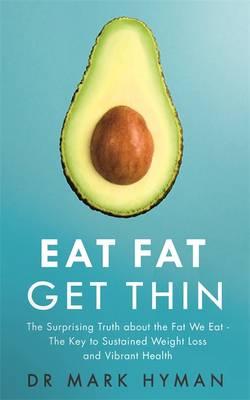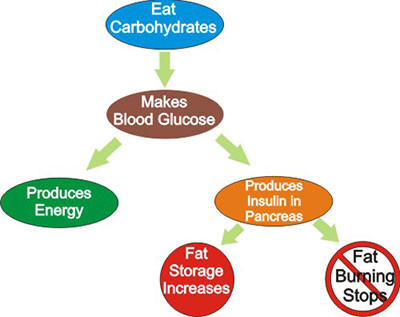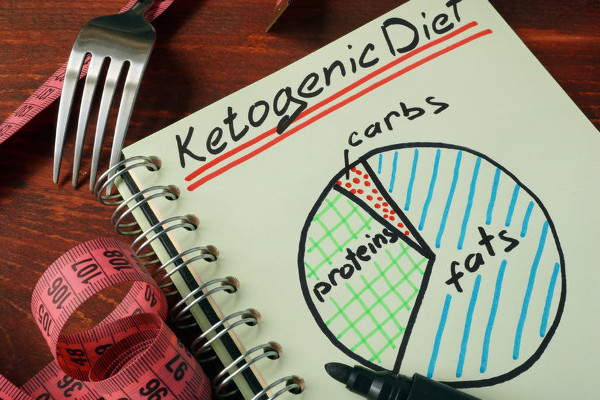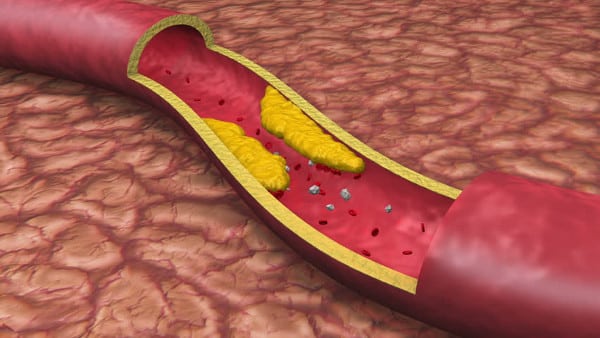For much of the last fifty or so years, the idea of eating low-fat to be thin, trim and heart healthy has dominated our dietary guidelines, health care system and food industry. It is an easy leap to assume that fat on your plate will translate to fat on your body or fat that may clog your arteries.
In spite of all the “healthy” fat-free and low-fat food options, the unfortunate reality is that the metabolic and cardiovascular health of Americans has only worsened during this same time period. In 1960, only 1 in 100 people had type 2 diabetes and 1 in 7 were obese. Today, 1 in 10 people have type 2 diabetes and 1 in 3 are obese. And heart disease continues to be the number one killer of both men and women.
Mounting evidence suggests that high-fat diets actually outperform low-fats diets when it comes to lasting weight loss and reversing the underlying factors that cause heart disease, diabetes and other metabolic conditions. While he once recommended low-fat diets to his patients, Dr. Mark Hyman points out in his book Eat Fat, Get Thin that careful examination of the scientific evidence supports the idea that “the more fat you eat, the more fat you lose and the better your body functions.”
Sugar Burner or Fat Burner
Our bodies have the capacity to generate energy from two different fuel systems. Since food was not always as readily available as it is for most people today, we are designed with the ability to utilize fat as an alternative fuel source. If levels of glucose from dietary carbohydrates drop too low and stored reserves are depleted, the liver produces ketones from dietary or body fat. Ketones are water-soluble molecules formed from fatty acids. Using ketones for fuel is what enabled our ancestors to survive in times when food was scarce and also what provides us with energy when we go without food for a period of time for whatever reasons.
Keep In mind that glucose is always the body’s first choice to use for energy production, assuming it is readily available in the bloodstream as it generally is when carbohydrates are regularly consumed. Any extra glucose the body does not need for immediate energy is either stored in the liver or muscle cells as glycogen to use when blood sugar drops low or it is converted to fat stores by the hormone insulin if limited glycogen reserves are full. Once excess carbohydrates turn to body fat, they are not easily accessed for fuel.

The problem with the body running primarily on glucose is that the constant spikes and dips in blood sugar that keep insulin levels elevated in the blood shut down fat burning and reduce ketone production. High insulin levels not only impair metabolism and make weight loss difficult but they also can lead to insulin resistance, inflammation, hormone imbalance and ultimately many of the types of chronic diseases people commonly suffer with today.
Nutritional Ketosis and the Ketogenic Diet
Nutritional ketosis is a metabolic state in which the body shifts from relying primarily on glucose for its fuel source to running on ketones generated in the liver from the breakdown of dietary or body fat. A ketogenic diet is a high-fat, moderate protein and very low-carb eating plan that reprograms the body to make the transition from primarily using glucose to produce energy to burning fat as its preferred fuel source.
While gaining in popularity in recent years, the ketogenic diet has actually been in practice since the 1920’s when it was first discovered and effectively used by physicians to reduce seizures in children with epilepsy. Similar very low-carb dietary modifications were also used to control diabetes before the advent of insulin injections (1922) and blood sugar reducing medications (1955). Even today at the Harvard Medical School affiliated Joslin Diabetes Center, a similar low-carb, high-fat dietary approach is used to improve blood sugar control in patients with type 2 diabetes. Adherence to the diet often allows medications to be reduced or, in some cases, discontinued.
How Does a Ketogenic Diet Work?
Making the shift from reliance on glucose to burning ketones for fuel involves radically lowering carbohydrate intake, keeping protein levels moderate and greatly increasing servings of good fats to fill up the energy deficit from reduced carbohydrates. The objective is to lower net carb grams (total carbohydrate grams minus dietary fiber grams) sufficiently to a point where blood sugar levels drop low enough to cause the body to use up most of its glycogen stores and turn to breaking down dietary fat and fat stores for fuel.
For maximum health benefits, nutrient-rich fibrous non-starchy vegetables should make up the majority of the carbohydrate grams consumed. Amounts of protein are limited to only what the body needs to maintain its lean muscle mass due to the fact that it is able to convert excess amino acids into glucose (moderate protein intake is one of the major differences between a ketogenic diet and the “Atkins” low-carb/high-fat diet that allows high-protein consumption).
 While a ketogenic diet need not involve counting calories, individuals do need to identify their ideal macronutrient ratio (how many grams of protein, carbs and fat they should consume) and track their food intake to discover the amounts that work best for them to achieve ketosis and become adapted to efficiently burning fat. Amounts of net carb and protein grams each individual can tolerate and remain in ketosis can vary depending on factors such as body size, activity level, weight-loss goals and metabolic and hormone health. The diet should be customized to the individual versus a “one size fits all” approach. In terms of percentage of total calories, a general range would be approximately 5-10 percent carbs, 20-25 percent protein and 65-80 percent healthy fats (keep in mind that fat has more than twice the calories of protein and carbs).
While a ketogenic diet need not involve counting calories, individuals do need to identify their ideal macronutrient ratio (how many grams of protein, carbs and fat they should consume) and track their food intake to discover the amounts that work best for them to achieve ketosis and become adapted to efficiently burning fat. Amounts of net carb and protein grams each individual can tolerate and remain in ketosis can vary depending on factors such as body size, activity level, weight-loss goals and metabolic and hormone health. The diet should be customized to the individual versus a “one size fits all” approach. In terms of percentage of total calories, a general range would be approximately 5-10 percent carbs, 20-25 percent protein and 65-80 percent healthy fats (keep in mind that fat has more than twice the calories of protein and carbs).
The amount of time it takes to transition from “sugar-burner” to “fat-burner” can also vary with each individual – anywhere from a matter of days to a few weeks. In cases of individuals with advanced insulin resistance or type 2 diabetes, it could take even longer.
Testing ketone levels is recommended to monitor levels of ketone production in order to know with certainty if you are eating the right amounts of carbs, proteins and fats required to maximize results. Once you identify your ideal ratio and have experienced what “fat-fueled” feels like, the whole experience becomes much easier and you will not need to test ketone levels as often.

Another plus is that you can experiment with adding more carbohydrate grams when you have been on the diet for a period of time and your body is well-adjusted to preferring fat for fuel. Often carbohydrate tolerance levels change as metabolic healing occurs and body composition improves. For a long-term plan, many experts recommend practicing “cyclical ketosis” or “carb refeeding” where carb grams are significantly increased on a periodic basis such as once a week. This can be useful for building muscle, restoring hormone balance, breaking a weight loss plateau, or other purpose unique to the individual. The practice is only advantageous once the body has become metabolically flexible enough to easily switch back to fat-burning. It is best not to use it in the initial stage of the diet.
What are the Primary Benefits of a Ketogenic Diet?
A ketogenic diet is known to benefit a wide range of conditions related to health and well-being. While one of the more popular benefits is the loss of excess weight (especially stubborn “belly” fat), the diet is able to address the root causes of many other types of health issues.
 Dr. Don Colbert, a physician who has practiced medicine for over 30 years and authored over 40 health-related books, states in his most recent book, The Keto Zone Diet, that he believes a ketogenic diet is “the healthiest diet in the world.” In his own practice, he has witnessed its benefits for significant and sustained weight loss (without the usual hunger and cravings), increased energy, improved mental clarity, memory and mood as well as improvements in measurable health parameters such as reduced levels of inflammation, blood sugar, insulin, blood pressure, and triglycerides as well as a healthier cholesterol profile. With the thousands of patients he has put on the diet, Dr. Colbert has found that many experienced greater relief from symptoms, reversal or even a complete cure from a number of conditions like arthritis, fibromyalgia, and migraines as well as chronic diseases such as type 2 diabetes, obesity, heart disease, Parkinson’s, Alzheimer’s, autoimmune diseases and even advanced cancers. While it is beyond the scope of this article to describe all the many benefits of a fat-fueled diet, the following are among the most noted by ketogenic diet advocates:
Dr. Don Colbert, a physician who has practiced medicine for over 30 years and authored over 40 health-related books, states in his most recent book, The Keto Zone Diet, that he believes a ketogenic diet is “the healthiest diet in the world.” In his own practice, he has witnessed its benefits for significant and sustained weight loss (without the usual hunger and cravings), increased energy, improved mental clarity, memory and mood as well as improvements in measurable health parameters such as reduced levels of inflammation, blood sugar, insulin, blood pressure, and triglycerides as well as a healthier cholesterol profile. With the thousands of patients he has put on the diet, Dr. Colbert has found that many experienced greater relief from symptoms, reversal or even a complete cure from a number of conditions like arthritis, fibromyalgia, and migraines as well as chronic diseases such as type 2 diabetes, obesity, heart disease, Parkinson’s, Alzheimer’s, autoimmune diseases and even advanced cancers. While it is beyond the scope of this article to describe all the many benefits of a fat-fueled diet, the following are among the most noted by ketogenic diet advocates:
IMPROVED BLOOD SUGAR CONTROL
Dramatically reducing dietary carbohydrates regulates blood sugar levels to prevent the inflammatory rise and fall of insulin. Keeping insulin levels low helps prevent or reverse conditions related to insulin resistance and disturbed metabolic function such as type 2 diabetes. When glucose and insulin levels remain low, insulin receptors are able to regain their sensitivity and, in time, insulin resistance can be reversed. Studies show a clear link between increased longevity and lower insulin levels in combination with greater insulin receptivity.
GREATER ENERGY
A state of ketosis improves the function of existing energy-producing mitochondria while stimulating the production of healthy new ones to generate even more ATP (the energy currency of the body used to run its systems). It is now known that ketones are able to generate more energy per molecule than glucose. Unlike the ups and downs in energy levels experienced when the body is dependent solely upon glucose, the energy ketones provide is much more stable and long lasting. Energy reserves are increased as well, since the body does not have to deal with all the extra free radicals generated by the oxidative stress that accompanies burning glucose for fuel.
WEIGHT LOSS
A ketogenic diet achieves more rapid and long-term body weight loss than low-fat or calorie deprivation diets and does so without the need to count calories, feel hungry or engage in excessive amounts of intense exercise. Once the body achieves the state of nutritional ketosis where it efficiently produces ketones, it literally becomes a “fat-burning machine.” Once adapted to fat-burning, most people find that pounds begin to steadily melt off until they reach a healthy body weight. Lowering insulin levels through carbohydrate restriction breaks the cycle of more and more fat storage while unlocking existing fat stores. In contrast, reliance on glucose for fuel results in higher insulin levels that can lead to the development of insulin resistance over time that result in increased fat storage and a sluggish metabolism. Rather than temporary weight loss, a ketogenic diet affords long-term benefits by healing metabolic dysfunction at the cellular level.
Lowering insulin levels through carbohydrate restriction breaks the cycle of more and more fat storage while unlocking existing fat stores. In contrast, reliance on glucose for fuel results in higher insulin levels that can lead to the development of insulin resistance over time that result in increased fat storage and a sluggish metabolism. Rather than temporary weight loss, a ketogenic diet affords long-term benefits by healing metabolic dysfunction at the cellular level.
LESS HUNGER AND BETTER APPETITE CONTROL
Hunger and cravings are substantially reduced once the body adjusts to burning fat for fuel since the release of fatty acids from fat cells provides a constant feast. Fat satisfies the body longer, making it easier to go without food for greater amounts of time. Without the spikes in insulin that drive up blood sugar levels from eating too many carbohydrates, low blood sugar “crashes” that trigger cravings and increased appetite are eliminated along with the temptation to snack unnecessarily or overeat. The ketogenic diet also helps balance hormones like leptin and ghrelin that are involved in controlling hunger and appetite.
REDUCED RISK FOR CARDIOVASCULAR DISEASE
Even though it is high in fat, the keto diet is capable of lowering cardiovascular risk factors in those who are obese or otherwise at risk. Studies have indicated that adherence to a ketogenic diet over a period of time decreased blood sugar, triglycerides and Pattern B LDL cholesterol in a significant percentage of study participants. Pattern B LDL is the more dangerous small dense particle type that leads to the buildup of plaque and resulting atherosclerosis. Regardless of total LDL, individuals who have greater numbers of Pattern B LDL are at a much higher risk of heart disease compared to those with larger LDL particles (pattern A LDL).

As long as polyunsaturated fats are limited and omega-3 fats are increased, the keto diet works to convert small, dense Pattern B LDL into the large, buoyant pattern A particles that are neutral and harmless. It also has also been shown to increase HDL levels for the vast majority of individuals, thereby helping to stabilize and even reverse plaque buildup in arteries. Moreover, eating a very low carbohydrate diet causes triglycerides in the blood to drop as saturated fats become a preferred fuel for the body.
But the most important way a ketogenic diet improves cardiovascular health is by eliminating the sugar and starchy carbohydrates (along with processed oils) that result in inflammation and the formation of oxidized small particle LDL cholesterol that damaged the lining of arteries in the first place. Keep in mind that the body only produces extra cholesterol as a normal response to inflammatory damage in an effort to repair it – addressing the root cause rather than inhibiting production with drugs is the best solution.
ENHANCED BRAIN HEALTH
The ketogenic diet is well known for lifting “brain fog” while enhancing cognitive function, memory and mood. According to a number of neurologists and research scientists, mental decline often begins when brain cells become insulin resistant and can no longer efficiently use glucose. In this state, they become highly inflamed from lack of energy. Since ketones do not require insulin to enter the cell, they provide a more readily available and efficiently used fuel source that helps maintain the health of aging brain cells.
A ketogenic diet is also thought to prevent or slow the development of neurodegenerative diseases such as Alzheimer’s. According to Dr. David Perlmutter, a renowned neurologist and author of Grain Brain and Brain Maker, a keto-type diet is able to improve cognitive function in Alzheimer’s patients and functionality in Parkinson’s patients even more than pharmaceutical drugs.
 Ketones also have anti-inflammatory properties and act as antioxidants as well that protect brain cells from free radical damage. In addition, they work to stimulate BDNF (Brain-derived neurotrophic factor), a protein that regulates the growth and normal development of connections between neurons in areas of the brain that are vital in learning, memory and higher thinking. Low levels of BDNF have been correlated with Alzheimer’s, depression, schizophrenia and other neurological disorders.
Ketones also have anti-inflammatory properties and act as antioxidants as well that protect brain cells from free radical damage. In addition, they work to stimulate BDNF (Brain-derived neurotrophic factor), a protein that regulates the growth and normal development of connections between neurons in areas of the brain that are vital in learning, memory and higher thinking. Low levels of BDNF have been correlated with Alzheimer’s, depression, schizophrenia and other neurological disorders.
ANTI-AGING AND LONGEVITY
The condition of our mitochondria (the “powerhouses” within our cells) plays a key role in our health and the rate at which our body ages. While it is normal for a certain amount of oxidative stress to take place as a byproduct of energy production within the mitochondria, excess amounts generate elevated levels of damaging free radicals that can lead to mitochondrial dysfunction. When this happens, the body is less able to produce energy and becomes more vulnerable to the development of degenerative diseases. Since fat is a much cleaner burning fuel, a ketogenic diet boosts mitochondrial function by reducing oxidative stress and free radical production by as much as 30-40 percent over what would normally take place with glucose metabolism. The reduction of oxidative stress and inflammation along with lowered glucose and insulin levels increases the cell’s ability to detoxify and repair itself. This, in turn, slows down the aging process.
In a global 2017 study published in The Lancet, the health and eating habits of 135,000 adults in 18 countries was observed for more than seven years on average. Researchers found that those with the highest intake of dietary fat were 23 percent less likely to have died during the study in contrast to those with the lowest fat intake. Further evidence of the increased longevity benefits of a low-carb, high-fat diet versus a high-carb, low-fat diet were evidenced by the study’s finding that participants with the highest carbohydrate intake were 28 percent more likely to have died than those with the lowest carbohydrate intake. The study also discovered that there was no correlation between fats and cardiovascular disease mortality though it did show an inverse association with regard to stroke risk. In other words, the more saturated fat was consumed, the fewer strokes occurred.
PROTECTION AGAINST ABNORMAL CELL GROWTH
It is well known that the proliferation of abnormal cells is fueled by glucose. While normal healthy cells are able to convert fat into energy, cancer cells cannot make the metabolic shift from glucose to ketones. Consuming a diet that causes the body to rely upon ketones for energy deprives these cells of their preferred fuel (glucose) and, in doing so, retards their growth since they must struggle to survive. Another way a ketogenic diet can prevent or help fight cancer is by optimizing mitochondria function within cells. This makes them less likely to experience damage and resulting mutations that could lead to cancer. A state of ketosis also mimics some of the lifespan-extending properties of calorie restriction and fasting, one of which is to clear out malfunctioning immune cells in a process known as autophagy.
Concluding Thoughts
In order to experience the many benefits of a ketogenic diet, one does need to be fully committed to following it correctly. It is also important to understand how to customize it and make necessary adjustments to meet the particular needs of your body. If you would like more information with guidelines and tips on the “how-to’s” of implementing a keto dietary approach or if you are interested in nutritional counseling for ways to make it work effectively for you, please e-mail me at [email protected].
Sources:
Fat for Fuel – Dr. Joseph Mercola
The Keto-Zone Diet – Dr. Don Colbert
Keto Clarity by Jimmy Moore with Eric Westman, M.D
Keto Beginning (e-book) by Leanne Vogel
Fat Fueled (e-book) by Leanne Vogel
Article Written by: Lucinda Bedogne, CNHP, CNC

